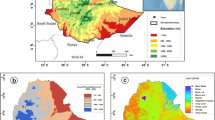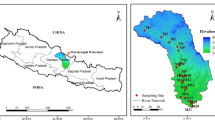Abstract
Scarcity of water is now the biggest threat in many parts of the world, specially in arid and semi arid regions. Establishing balance between water resources and the demands in a catchment scale basis could be one of the most important strategies to overcome this problem. In this regard, determination and analysis of water balance components (inputs and outputs) would be necessary. This study has focused on estimation of water balance components in arid-mountainous catchment of Manshad in Yazd province of Iran, during the year 2006–2007 using remote sensing and GIS techniques. To estimate actual evapotranspiration (ETa) of the catchment, time series of MODIS images were obtained and used via Surface Energy Balance Algorithm for Land (SEBAL) approach. Measured precipitation (P) and runoff (R) data of the catchment were also used to calculate water balance equation components. Results indicated that a large volume of catchment water (about 70%) is wasted through evapotranspiration, while the rainfall is not enough to compensate this volume of water during the year. It seems that the negative (descending) trend has become dominant to the water budget of the area and gradually moves to harsh conditions of water shortage in future decades. Therefore, some actions would be necessary to overcome the problem. Water conservation strategies‚ improvement of water use efficiency, and control on agricultural field expansions are some solutions that could be advised for the studied catchment.





Similar content being viewed by others
References
Abdulla F, Eshtawi T, Assaf H (2009) Assessment of the impact of potential climate changeon the water balance of a semi-arid watershed. Water Resour Manag 23:2051–2068
Allen R, Pereira LS, Raes D, Smith M, (1998) Crop evapotranspiration: guidelines for computing crop requirements. FAO Irrigation and Drainage Paper No. 56, Rome: Italy
Allen RG, Tasumi M, Morse AT, Trezza R (2005) A landsat-based energy balance and evapotranspiration model in Western US water rights regulation and planning. J Irrigat Drain Syst 19(3–4):251–268(18)
Bastiaanssen WGM (2000) SEBAL-based sensible and latent heat fluxes in the irrigated Gediz Basin, Turkey. J Hydrol 229:87–100
Bastiaanssen WGM, Menenti M, Feddes RA, Holtslag AAM (1998a) A remote sensing surface energy balance algorithm for land (SEBAL). J Hydrol 212–213
Bastiaanssen WGM, Menenti M, Feddes RA, Holtslag AAM (1998b) A remote sensing surface energy balance algorithm for land (SEBAL): 1) Formulation. J Hydrol 212(213):213–229
Bastiaanssen WGM, Ahmad MD, Chemin Y (2002) Satellite surveillance of evaporative depletion across the Indus Basin. Water Resour Res 38(12):1273
Chami DE, Moujabber ME, Scardigno A (2009) Regional water balance and economic assessmentas tools for water management in Coastal Lebanon. Water Resour Manag 23:2361–2378
Chen J-F, Lee C-H, Yeh T-C, Yu J-L (2005) A water budget model for the Yun-Lin Plain, Taiwan. Water Resour Manag 19:483–504
Dankers R (2001) A large scale water balance model of the Tana river basin, ICG report 01/2, Utrecht, Center for Geological Research, Faculty of Geographical Sciences, University of Utrecht
Dingman SL (2002) Physical hydrology. Upper Saddle River, Prentice Hall
Elhag M, Psilovikos A, Manakos I, Perakis K (2011) Application of the Sebs water balance modelin estimating daily evapotranspirationand evaporative fraction from remotesensing data over the Nile Delta. Water Resour Manag 25:2731–2742
Fujihara Y, OdaM, Horikawa N, Ogura C (2011) Hydrologic analysis of rainfed rice areas using a simple semi-distributed water balance model. Water Resour Manag 25:2061–2080
He B, Wang Y, Takase K, Mouri G, Razafindrabe BHN (2009) Estimating land use impacts on regional scale urbanwater balance and groundwater recharge. Water Resour Manag 23:1863–1873
Heafner H, Schumann AH (1992) Remote sensing applications in hydrology and water resources management. Department of Geography, University of Zurich, Zurich
Höllermann B, Giertz S, Diekkrüger B (2010) Benin 2025—balancing future water availabilityand demand using the WEAP ‘Water Evaluationand Planning’ system. Water Resour Manag 24:3591–3613
Jasrotia AS, Majhi A, Singh S (2009) Water balance approach for rainwater harvestingusing remote sensing and GIS techniques, Jammu Himalaya, India. Water Resour Manag 23:3035–3055
Manghi F, Mortazavi B, Crother C, Hamdi MR (2009) Estimating regional groundwater recharge usinga hydrological budget method. Water Resour Manag 23:2475–2489
Nhedzi E (2008) Assessment of a catchment water balance using GIS and remote sensing techniques: Mazowe, Zimbabwe, MSc thesis, ITC, the Netherlands
Rientjes THM (2007) Modeling in hydrology, Department of water resources, ITC, Enschede, the Netherlands
Senay GB, Budde M, Verdin JP, Melesse AM (2007) A coupled remote sensing and simplified surface energy balance approach to estimate actual evapotranspiration from irrigated fields. Sensors 2007(7):979–1000
Setegn SG, Chowdary VM, Mal BC, Yohannes F, Kono Y (2011) Water balance study and irrigation strategiesfor sustainable management of a tropicalEthiopian lake: a case study of lake Alemaya. Water Resour Manag 25:2081–2107
Smith DI, Stopp P (1978) The River basin: an introduction to the study of hydrology (Cambridge topics in geography), Cambridge University Press
Tang Q, Hu H, Oki T, Tian F (2007) Water balance within intensively cultivated alluvial plain in an arid environment. Water Resour Manag 21:1703–1715
Xu CY (1999) Estimation of parameters of a conceptual water balance model for ungauged catchments. Water Resour Manag 13:353–368
Xu CY, Singh VP (1998) A review on monthly water balance models for water resources investigations. Water Resour Manag 12:31–50
Acknowledgement
This research describes work undertaken as MSc thesis submitted to Yazd University of Iran. Special thanks go to Eng. M.H. Rahimian, Eng. M. H. Mokhtari and Dr. S. A. M. Cheraghi for their great supports, helps and encouragements.
Author information
Authors and Affiliations
Corresponding author
Rights and permissions
About this article
Cite this article
Dastorani, M.T., Poormohammadi, S. Evaluation of Water Balance in a Mountainous Upland Catchment Using SEBAL Approach. Water Resour Manage 26, 2069–2080 (2012). https://doi.org/10.1007/s11269-012-9999-y
Received:
Accepted:
Published:
Issue Date:
DOI: https://doi.org/10.1007/s11269-012-9999-y




